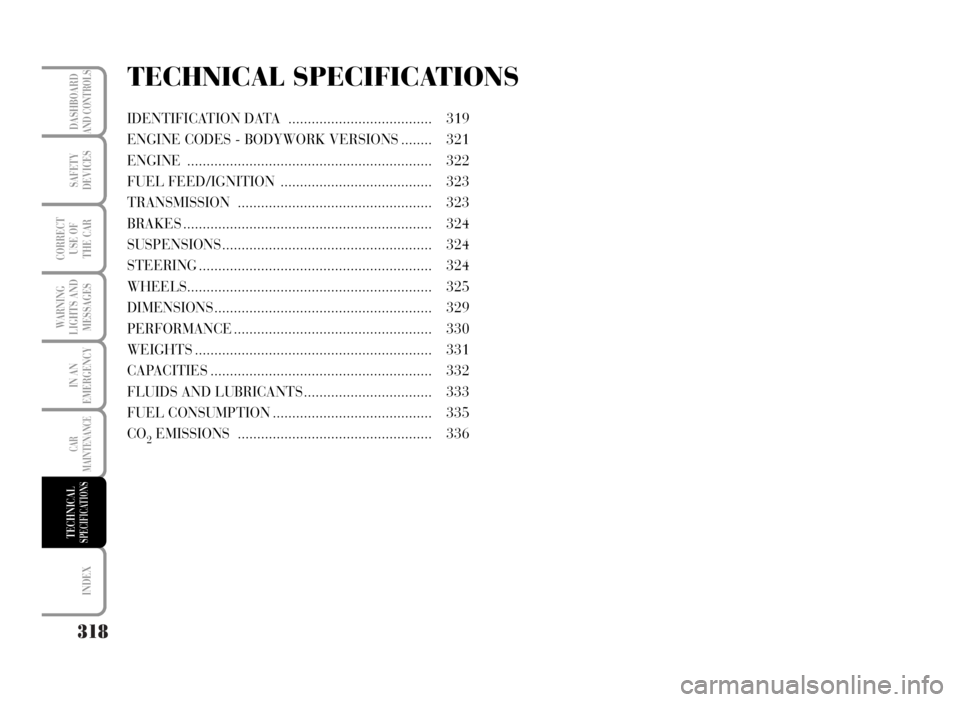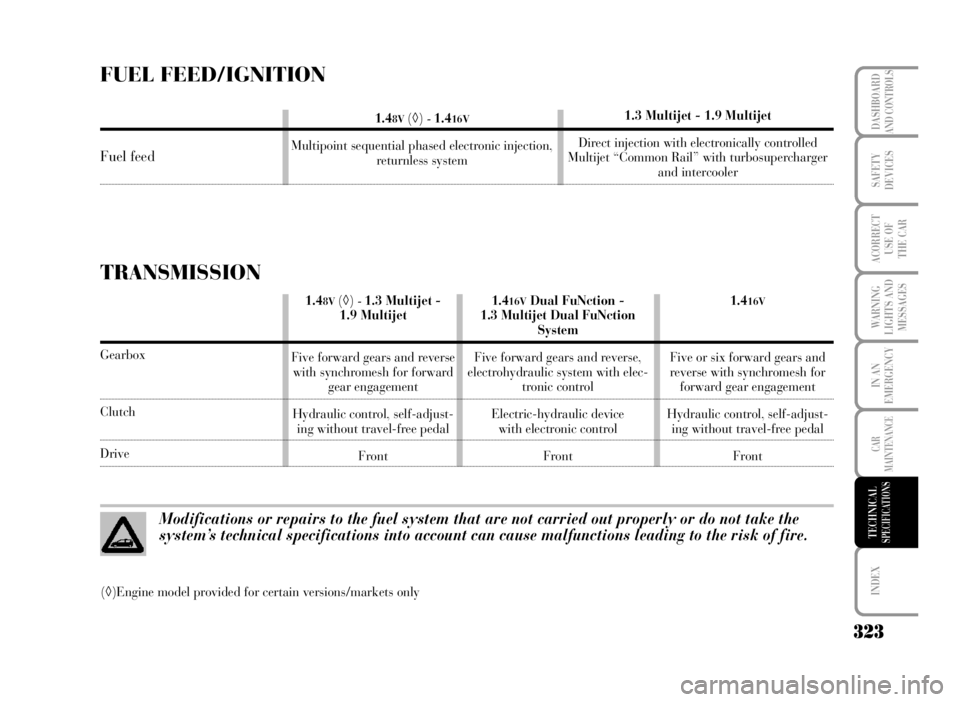warning Lancia Musa 2007 Owner handbook (in English)
[x] Cancel search | Manufacturer: LANCIA, Model Year: 2007, Model line: Musa, Model: Lancia Musa 2007Pages: 346, PDF Size: 5.15 MB
Page 315 of 346

314
WARNING
LIGHTS AND
MESSAGES
TECHNICALSPECIFICATIONS
INDEX
DASHBOARD
AND CONTROLS
SAFETY
DEVICES
CORRECT
USE OF
THE CAR
IN AN
EMERGENCY
CAR
MAINTENANCE
BODYWORK
PROTECTION FROM ATMOSPHERIC AGENTS
The main causes of corrosion are the following:
❒atmospheric pollution;
❒salty air and humidity (coastal areas, or hot
humid climates);
❒seasonal environment conditions.
Not to be underestimated is also the abrasive action
of wind-borne atmospheric dust and sand and mud
and gravel raised by other vehicles.
Lancia implemented the best manufacturing
technologies to effectively protect the bodywork
against corrosion.These include:
❒Painting products and systems which give the
car particular resistance to corrosion and
abrasion;
❒Use of galvanised (or pretreated) steel sheets,
with high resistance to corrosion;
❒Spraying of plastic parts, with a protective
function, in the more exposed points: underdoor,
inner fender parts, edges, etc.;
❒Use of “open” boxed sections to prevent
condensation and pockets of moisture from
triggering rust inside.
BODY AND UNDERBODY
WARRANTY
Your Lancia Idea is covered by warranty against
perforation due to rust of any original element of
the structure or body. For the general terms of this
warranty, refer to “Warranty Booklet”.
Page 316 of 346

315
WARNING
LIGHTS AND
MESSAGES
TECHNICALSPECIFICATIONS
INDEX
DASHBOARD
AND CONTROLS
SAFETY
DEVICES
CORRECT
USE OF
THE CAR
IN AN
EMERGENCY
CAR
MAINTENANCE
ADVICE FOR PRESERVING THE BODYWORK
Paint
Paintwork does not only serve an aestethic purpose,
but also protects the underlying sheet metal.
In the case of deep scrapes or scores, you are
advised to have the necessary touching up carried
out immediately to avoid the formation of rust. Use
only original paint products for touching up (see
“Bodywork paint identification plate” in section
“Technical specification”).
Normal paint maintenance consists in washing at
intervals depending on the conditions and
environment of use. For example, in highly polluted
areas, or if the roads are sprayed with salt, it is wise
to wash the car more frequently.
To correctly wash the car:
❒remove the aerial from the roof to prevent
damage to it if the car is washed in an automatic
system;
❒wash the body using a low pressure jet of water;
❒wipe a sponge with a slightly soapy solution over
the bodywork, frequently rinsing with the
sponge;
❒rinse well with water and dry with a jet of air or
a chamois leather.
When drying, take particular care with the less
visible parts like door surrounds, bonnet and
around the headlights where water may stagnate.
The car should not be taken to a closed area
immediately, but left in the open so that residual
water can evaporate.
Do not wash the car after it has been left in the sun
or with the bonnet hot: this may alter the shine of
the paintwork.
Exterior plastic parts must be cleaned in the same
way as the rest of the vehicle.
Where possible, do not park under trees; the
resinous substance many species release give the
paint a dull appearance and increase the possibility
of triggering rust processes.
IMPORTANT Bird droppings must be washed off
immediately and thoroughly as the acid they
contain is particularly aggressive.
Detergents cause water pollution. Therefore the car should be washed in areas equipped for
collecting and purifying the liquid used in the washing process.
Page 317 of 346

316
WARNING
LIGHTS AND
MESSAGES
TECHNICALSPECIFICATIONS
INDEX
DASHBOARD
AND CONTROLS
SAFETY
DEVICES
CORRECT
USE OF
THE CAR
IN AN
EMERGENCY
CAR
MAINTENANCE
Windows
Use specific window cleaner products. Use also
clean cloths to avoid scratching the glass or
damaging the transparency.
IMPORTANT The inside of the rearscreen should be
wiped gently with a cloth in the direction of the
filaments to avoid damaging the heating device.
Front headlights
IMPORTANT Never use aromatic substances (e.g.:
petrol) or ketones (e.g.: acetone) for cleaning front
headlight plastic lens.Engine compartment
At the end of the winter the engine compartment
should be carefully washed, without directing the jet
against electronic control units. Contact a
specialised workshop to have this done.
IMPORTANT Washing should be carried out with
the engine cold and the ignition key at STOP. After
washing make sure that the various protections
(e.g.: rubber caps and various covers) have not been
damaged or removed.
Never use flammable products like oil ether or rectified petrol for cleaning car
interiors. Electrostatic discharges generated by rubbing during cleaning
operations could cause fire.
WARNING
Page 318 of 346

317
WARNING
LIGHTS AND
MESSAGES
TECHNICALSPECIFICATIONS
INDEX
DASHBOARD
AND CONTROLS
SAFETY
DEVICES
CORRECT
USE OF
THE CAR
IN AN
EMERGENCY
CAR
MAINTENANCE
INTERIORS
Periodically check that water is not trapped under
the mats (due to water dripping off shoes,
umbrellas, etc.) which could cause oxidisation of the
sheet metal.
CLEANING SEATS AND FABRIC AND VELVET
PA R T S
Use a soft brush or vacuum cleaner to remove dust.
Velvet is cleaned better if the brush is moistened.
Rub the seats with a sponge moistened with a
solution of water and neutral detergent.
INTERIOR PLASTIC PARTS
For routine cleaning, wipe with a cloth with water
and neutral non-abrasive detergent. Remove grease
or persistent stains with appropriate products
designed to preserve the appearance of components.
IMPORTANT Never use spirit or petroleum to clean
the instrument panel or other plastic parts.STEERING WHEEL/GEAR LEVER KNOB
WITH GENUINE LEATHER COVERING
These components shall only be cleaned with water
and neutral soap. Never use spirit or alcohol-based
products.
Before using special products for cleaning interiors,
read carefully label instructions and indications to
make sure they are free from spirit and/or alcohol-
based substances.
If when cleaning the windscreen with special glass
products, some drops fall on the leather covering of
the steering wheel/gear lever knob remove them
immediately and then clean with water and neutral
soap.
IMPORTANT Take the utmost care when engaging
the steering lock to prevent scratching the leather
covering.
Do not keep aerosol cans in the car: they might explode. Aerosol cans must never
be exposed to a temperature above 50°C. The temperature inside the car exposed
to the sun may go well beyond that figure.
WARNING
Page 319 of 346

318
WARNING
LIGHTS AND
MESSAGES
INDEX
DASHBOARDAND CONTROLS
SAFETY
DEVICES
CORRECT
USE OF
THE CAR
IN AN
EMERGENCY
CAR
MAINTENANCE
TECHNICALSPECIFICATIONS
TECHNICAL SPECIFICATIONS
IDENTIFICATION DATA ..................................... 319
ENGINE CODES - BODYWORK VERSIONS ........ 321
ENGINE ............................................................... 322
FUEL FEED/IGNITION ....................................... 323
TRANSMISSION .................................................. 323
BRAKES ................................................................ 324
SUSPENSIONS ...................................................... 324
STEERING ............................................................ 324
WHEELS............................................................... 325
DIMENSIONS ........................................................ 329
PERFORMANCE ................................................... 330
WEIGHTS ............................................................. 331
CAPACITIES ......................................................... 332
FLUIDS AND LUBRICANTS ................................. 333
FUEL CONSUMPTION ......................................... 335
CO
2EMISSIONS .................................................. 336
Page 320 of 346

IDENTIFICATION DATA
You are advised to note the identification codes. The identification
data stamped and given on the plates and their position are the
following:
1 - Model plate
2 - Chassis marking
3 - Bodywork paint identification plate
4 - Engine marking.
MODEL PLATE
The plate is to be found on the front crossmember of the engine
compartment and bears the following identification data:
A - Manufacturer’ name.
B - Homologation number.
C - Vehicle type code.
D - Chassis number.
E - Maximum vehicle weight fully loaded.
F - Maximum vehicle weight fully loaded with trailer.
G - Maximum vehicle weight on front axle.
H - Maximum vehicle weight on rear axle.
I - Engine type.
L - Body version code.
M - Spare part code.
N - Smoke opacity index (for diesel engines).
319
WARNING
LIGHTS AND
MESSAGES
INDEX
DASHBOARDAND CONTROLS
SAFETY
DEVICES
ACORRECT
USE OF
THE CAR
IN AN
EMERGENCY
CAR
MAINTENANCE
TECHNICALSPECIFICATIONS
L0D0225m
L0D0226m
Page 321 of 346

CHASSIS MARKING
It is printed on the passenger compartment floor, near the right-hand
front seat.
It can be reached by lifting the special flap in the carpeting and
includes the following data:
❒car model;
❒chassis number.
BODYWORK PAINT
IDENTIFICATION PLATE
It is applied on front bonnet and shows following data:
A - Paint manufacturer.
B - Colour name.
C - Lancia colour code.
D - Respray and touch up code.
ENGINE MARKING
Engine marking is stamped on the cylinder block on passenger
compartment side and includes the model and the chassis number.
320
WARNING
LIGHTS AND
MESSAGES
INDEX
DASHBOARDAND CONTROLS
SAFETY
DEVICES
CORRECT
USE OF
THE CAR
IN AN
EMERGENCY
CAR
MAINTENANCE
TECHNICALSPECIFICATIONS
L0D0228m
L0D0227m
Page 322 of 346

ENGINE CODES - BODYWORK VERSIONS
Versions
1.48V(◊)
1.416V
1.416VDual FuNction System
1.3 Multijet 70HP
1.3 Multijet 70 HP Dual FuNction System
1.3 Multijet 90HP
1.3 Multijet 90 HP Dual FuNction System
1.9 Multijet
(◊) Engine model provided for certain versions/markets only
(*) Version with DPF
321
WARNING
LIGHTS AND
MESSAGES
INDEX
DASHBOARDAND CONTROLS
SAFETY
DEVICES
ACORRECT
USE OF
THE CAR
IN AN
EMERGENCY
CAR
MAINTENANCE
TECHNICALSPECIFICATIONS
Engine code
350A1000
843A1000
843A1000
188A9000
188A9000
199A3000
199A3000
188B2000Bodywork version code
350 AXF1A 08CL
350 AXA1B 07 CL
350 AXA11 04 CL
350 AXBIA 01 BL
350 AXB11 05 BL
350 AXG1A 09 NL (4-seat)
350 AXG1A 09 ML (5-seat)
350 AXG1A 09 TL (4-seat) (*)
350 AXG1A 09 SL (5-seat) (*)
350 AXG11 09 HL (4-seat)
350 AXG11 09 GL (5-seat)
350 AXG1A 02 GL
Page 323 of 346

322
WARNING
LIGHTS AND
MESSAGES
INDEX
DASHBOARDAND CONTROLS
SAFETY
DEVICES
CORRECT
USE OF
THE CAR
IN AN
EMERGENCY
CAR
MAINTENANCE
TECHNICALSPECIFICATIONS
1.3 Multijet 70HP
188A9000
Diesel
4 in line
4
69.6 x 82
1248
18±0.4
51
70
4000
180
18.3
1750
–
Unleaded petrol
95 RON (EN228
Specifications)1.3 Multijet 90HP
199A3000
Diesel
4 in line
4
69.6 x 82
1248
17.6±0.4
66
90
4000
200
20
1750
–
Diesel fuel for
motor vehicles
(EN590
Specifications)1.9 Multijet
188B2000
Diesel
4 in line
2
82 x 90.4
1910
18±1
74
100
4000
260
26.4
2000
–
Diesel fuel for
motor vehicles
(EN590
Specifications) 1.4
8V◊)
350A1000
Otto
4 in line
2
72 x 84
1368
11±0.2
57
77
6000
115
11.7
3000
NGK ZKR7A-10
Unleaded petrol
95 RON (EN228
Specifications)1.4
16V
843A1000
Otto
4 in line
4
72 x 84
1368
11±0.2
70
95
5800
128
13
4500
NGK ZKR7A-10
Unleaded petrol
95 RON (EN228
Specifications)
ENGINE
GENERAL FEATURES
Engine code
Cycle
Number and layout of cylinders
Valves per cylinder
Piston bore and stroke mm
Total displacement cm3
Compression ratio
Maximum power (EEC) kW
HP
corresponding ratio: rpm
Maximum torque (EEC) Nm
kgm
corresponding ratio: rpm
Spark plugs
Fuel
◊) Engine model provided for certain versions/markets only
Page 324 of 346

Modifications or repairs to the fuel system that are not carried out properly or do not take the
system’s technical specifications into account can cause malfunctions leading to the risk of fire.
(◊)Engine model provided for certain versions/markets only
1.48V(◊)-1.416V
Multipoint sequential phased electronic injection,
returnless system
TRANSMISSION
Gearbox
Clutch
Drive1.4
8V(◊)-1.3 Multijet -
1.9 Multijet
Five forward gears and reverse
with synchromesh for forward
gear engagement
Hydraulic control, self-adjust-
ing without travel-free pedal
Front
323
WARNING
LIGHTS AND
MESSAGES
INDEX
DASHBOARDAND CONTROLS
SAFETY
DEVICES
ACORRECT
USE OF
THE CAR
IN AN
EMERGENCY
CAR
MAINTENANCE
TECHNICALSPECIFICATIONS
1.416VDual FuNction -
1.3 Multijet Dual FuNction
System
Five forward gears and reverse,
electrohydraulic system with elec-
tronic control
Electric-hydraulic device
with electronic control
Front1.416V
Five or six forward gears and
reverse with synchromesh for
forward gear engagement
Hydraulic control, self-adjust-
ing without travel-free pedal
Front
FUEL FEED/IGNITION
Fuel feed
1.3 Multijet - 1.9 Multijet
Direct injection with electronically controlled
Multijet “Common Rail” with turbosupercharger
and intercooler